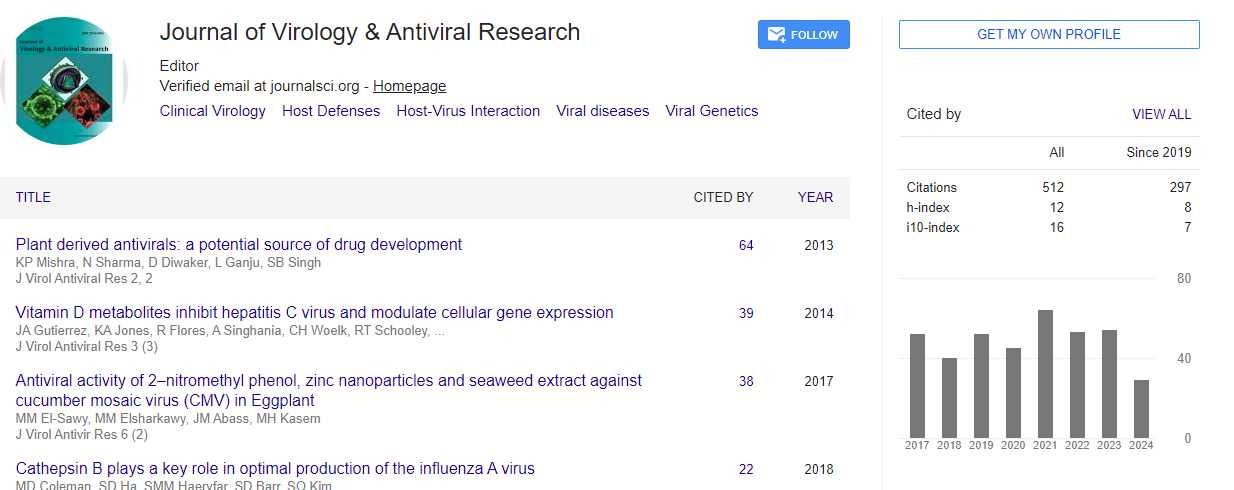Opinion Article, J Virol Antivir Vol: 12 Issue: 2
Viral Proteomics: Decoding the Intricate World of Viral Proteins
Stephan Phillips*
1Department of Neurology and Neurosurgery, Utrecht University, Utrecht, The Netherlands
*Corresponding Author: Stephan Phillips,
Department of Neurology and
Neurosurgery, Utrecht University, Utrecht, The Netherlands
E-mail: sp34@umcht.nl
Received date: 29 May, 2023, Manuscript No. JVA-23-107863;
Editor assigned date: 31 May, 2023, PreQC No. JVA-23-107863 (PQ);
Reviewed date: 14 June, 2023, QC No. JVA-23-107863;
Revised date: 21 June, 2023, Manuscript No. JVA-23-107863 (R);
Published date: 28 June, 2023, DOI: 10.4172/2324-8955.1000680
Citation: Phillips S (2023) Viral Proteomics: Decoding the Intricate World of Viral Proteins. J Virol Antivir Res 12:2.
Abstract
Description
Viral infections have been a persistent threat to human health throughout history. To combat viral diseases effectively, researchers delve into the molecular intricacies of viral proteins through a field known as viral proteomics. Viral proteomics involves the systematic study of the complete set of proteins expressed by viruses during different stages of infection. By understanding the functions and interactions of viral proteins, researchers gain valuable insights into viral pathogenesis, host-virus interactions, and potential therapeutic targets. In this article, we explore the fascinating world of viral proteomics, its methodologies, and the significant impact it has on advancing our knowledge of viral diseases and developing innovative antiviral strategies.
Understanding viral proteins
Viruses are obligate intracellular parasites that lack the cellular machinery necessary for independent replication. Instead, they hijack the host cell's resources to replicate and produce viral progeny. Viral proteins play a pivotal role in this process, enabling viruses to interact with host cells, evade immune responses, replicate their genomes, and assemble new viral particles. Viral proteomics aims to identify, characterize, and quantify the complete set of proteins expressed by a virus during infection. This involves the study of both viral structural proteins, which form the viral capsid and envelope, and non-structural proteins, which participate in various stages of the viral life cycle.
Methodologies in viral proteomics
Viral proteomics employs a range of cutting-edge techniques to unravel the complex protein landscape of viruses. Some key methodologies include:
Mass spectrometry: Mass spectrometry is a powerful tool used to identify and quantify proteins in a sample. In viral proteomics, mass spectrometry is used to analyze viral protein expression during infection and to study post-translational modifications, such as phosphorylation or glycosylation.
Two-dimensional gel electrophoresis: This technique separates proteins based on their isoelectric point and molecular weight, providing information on the size and charge of viral proteins.
Liquid chromatography: Liquid chromatography is often coupled with mass spectrometry to improve the sensitivity and resolution of viral proteomics experiments.
Protein-protein interaction studies: Understanding how viral proteins interact with host cell proteins is crucial for deciphering viral pathogenesis. Techniques like yeast two-hybrid assays and coimmunoprecipitation help identify and characterize protein-protein interactions.
Roles of viral proteins in viral pathogenesis
Viral entry: Viral proteins on the surface of the virus play a crucial role in attaching to host cell receptors and facilitating viral entry into the host cell. Understanding these interactions helps develop entry inhibitors as potential antiviral therapeutics.
Replication: Non-structural viral proteins often orchestrate viral genome replication and transcription within the host cell. Targeting these proteins disrupts viral replication and prevents the production of new viral progeny.
Immune evasion: Viral proteins may suppress the host's immune response or evade immune detection to establish persistent infections. Identifying these immunomodulatory proteins opens avenues for developing immune-based antiviral strategies.
Pathogenicity: Certain viral proteins contribute to the virulence and pathogenicity of viruses. Through proteomics, researchers can identify the virulence factors responsible for severe disease outcomes.
Host-virus interactions
Viral proteomics plays a crucial role in understanding host-virus interactions, offering insights into how viruses manipulate host cellular pathways for their benefit. By studying the interactions between viral and host proteins, researchers can uncover the molecular mechanisms governing viral pathogenesis and identify potential therapeutic targets.
Viral immune evasion: Many viruses encode proteins that target host immune responses, leading to immune evasion and allowing the virus to evade detection and clearance. Proteomic studies have revealed key viral immune evasion strategies, such as inhibition of interferon signaling or downregulation of Major Histocompatibility Complex (MHC) molecules.
Modulation of cellular signaling: Viral proteins may interfere with host cell signaling pathways to promote viral replication and survival. Understanding these interactions aids in developing antiviral strategies that disrupt these signaling events.
Viral hijacking of host proteins: Some viral proteins mimic or interact with host cell proteins to subvert cellular processes for viral benefit. Proteomic studies have identified such viral mimics and shed light on the consequences of viral hijacking of host machinery.
Therapeutic implications of viral proteomics
The wealth of information obtained from viral proteomics has significant therapeutic implications in antiviral drug discovery and vaccine development. Viral proteomics identifies critical viral proteins that are essential for viral replication and pathogenesis. These proteins serve as potential targets for antiviral drugs that inhibit viral replication or disrupt viral protein functions. Proteomic studies help identify immunogenic viral proteins that can serve as vaccine candidates. By targeting these viral proteins, vaccines can induce strong immune responses and confer protection against viral infections.
Conclusion
Viral shedding and transmission dynamics are critical factors in the spread of infectious diseases. Understanding the factors influencing viral shedding, routes of transmission, and their implications for public health is crucial for controlling outbreaks and preventing the spread of viruses. By implementing effective infection control measures, contact tracing, vaccination strategies, and clear public health messaging, we can mitigate the impact of viral infections and protect vulnerable populations. Continued research and surveillance on viral shedding and transmission dynamics are vital to adapt and refine public health strategies, especially in the face of emerging viral threats. Collaborative efforts between researchers, healthcare professionals, and public health authorities are essential to ensure a comprehensive and evidence-based approach to preventing the spread of infectious diseases.
 Spanish
Spanish  Chinese
Chinese  Russian
Russian  German
German  French
French  Japanese
Japanese  Portuguese
Portuguese  Hindi
Hindi 

